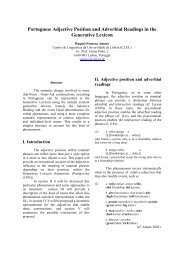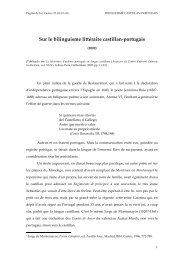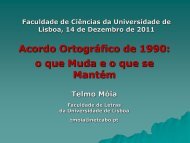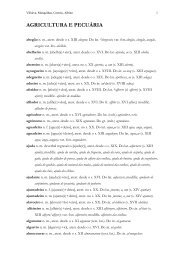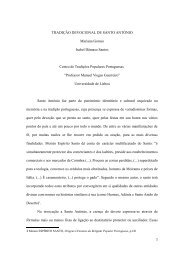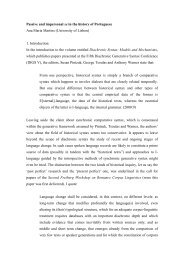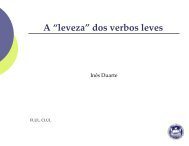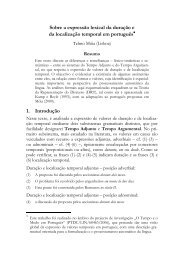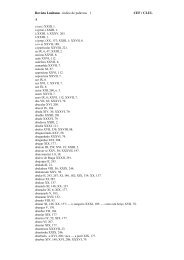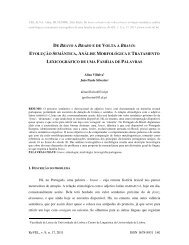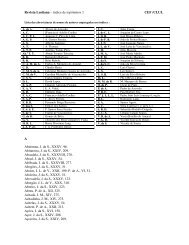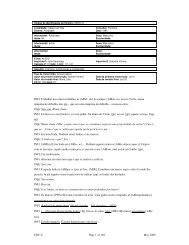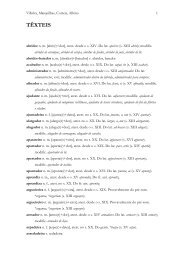Modeling adjectives in GL: accounting for all adjective classes - CLUL
Modeling adjectives in GL: accounting for all adjective classes - CLUL
Modeling adjectives in GL: accounting for all adjective classes - CLUL
You also want an ePaper? Increase the reach of your titles
YUMPU automatically turns print PDFs into web optimized ePapers that Google loves.
<strong>Model<strong>in</strong>g</strong> <strong><strong>adjective</strong>s</strong> <strong>in</strong> <strong>GL</strong>: account<strong>in</strong>g <strong>for</strong> <strong>all</strong> <strong>adjective</strong> <strong>classes</strong> 1<br />
Sara Mendes Raquel Amaro<br />
Group <strong>for</strong> the Computation of Lexical Grammatical Knowledge<br />
Centre of L<strong>in</strong>guistics, University of Lisbon<br />
Avenida Professor Gama P<strong>in</strong>to, 2<br />
1649-003 Lisboa - Portugal<br />
{sara.mendes;ramaro}@clul.ul.pt<br />
Abstract 1<br />
Appear<strong>in</strong>g <strong>in</strong> different positions <strong>in</strong> the sentence,<br />
as a modifier of the noun or as complements<br />
of verbs, <strong><strong>adjective</strong>s</strong>, more than any other<br />
POS, can take different mean<strong>in</strong>gs depend<strong>in</strong>g<br />
on the l<strong>in</strong>guistic context they occur <strong>in</strong>. But,<br />
despite the different complex phenomena <strong>in</strong>volved<br />
<strong>in</strong> the l<strong>in</strong>guistic behavior of <strong><strong>adjective</strong>s</strong>,<br />
most research developed on this POS has focused<br />
on very specific phenomena, such as<br />
sense change or secondary predication. In this<br />
paper we analyze and model <strong>adjective</strong> <strong>classes</strong>,<br />
identify<strong>in</strong>g their characteriz<strong>in</strong>g features and<br />
putt<strong>in</strong>g <strong>for</strong>th a proposal <strong>for</strong> represent<strong>in</strong>g them<br />
<strong>in</strong> the lexicon. We discuss <strong>adjective</strong> representation<br />
<strong>in</strong> <strong>GL</strong>, del<strong>in</strong>eat<strong>in</strong>g model<strong>in</strong>g strategies<br />
to accurately represent <strong>all</strong> <strong>adjective</strong> as complex<br />
and dynamic objects, show<strong>in</strong>g how lexical<br />
representations can account <strong>for</strong> the relevant<br />
syntactic and semantic behavior of these items.<br />
1 Introduction<br />
Despite <strong>all</strong> the different complex phenomena<br />
<strong>in</strong>volved <strong>in</strong> the l<strong>in</strong>guistic behavior of <strong><strong>adjective</strong>s</strong>,<br />
most work developed on this POS has focused on<br />
sense change (see Bouillon (1998) and Amaro<br />
(2002) <strong>for</strong> sense change analyses <strong>in</strong> the Generative<br />
Lexicon framework).<br />
In this paper we do not focus on a specific<br />
phenomenon <strong>in</strong>volv<strong>in</strong>g <strong><strong>adjective</strong>s</strong>, but rather analyze<br />
and model this POS as a class, identify<strong>in</strong>g<br />
its characteriz<strong>in</strong>g features and putt<strong>in</strong>g <strong>for</strong>th a<br />
proposal <strong>for</strong> represent<strong>in</strong>g it <strong>in</strong> the lexicon. In order<br />
to achieve this objective, we adopt the <strong>GL</strong><br />
framework (Pustejovsky, 1991; Pustejovsky,<br />
1995), s<strong>in</strong>ce this model l<strong>in</strong>ks the different mod-<br />
1 The research presented <strong>in</strong> this paper was supported by<br />
Fundação para a Ciência e a Tecnologia (grants<br />
SFRH/BD/8524/2002 and SFRH/BD/13875/2003).<br />
ules of Grammar <strong>in</strong> a very <strong>in</strong>tuitive way, <strong>all</strong>ow<strong>in</strong>g<br />
<strong>for</strong> a simultaneously thorough and economic<br />
model<strong>in</strong>g of the data.<br />
We start by present<strong>in</strong>g a description of the<br />
most relevant aspects <strong>in</strong>volved <strong>in</strong> the l<strong>in</strong>guistic<br />
behavior of <strong><strong>adjective</strong>s</strong>, <strong>in</strong> section 2, identify<strong>in</strong>g<br />
several different <strong>adjective</strong> <strong>classes</strong> based on the<br />
syntactic and semantic contrasts displayed by the<br />
lexical items belong<strong>in</strong>g to this POS. Based on the<br />
generalizations obta<strong>in</strong>ed from the data, <strong>in</strong> section<br />
3 we discuss <strong>adjective</strong> representation <strong>in</strong> <strong>GL</strong>, del<strong>in</strong>eat<strong>in</strong>g<br />
model<strong>in</strong>g strategies to accurately<br />
represent <strong>all</strong> <strong>adjective</strong> <strong>classes</strong> <strong>in</strong> the lexicon as<br />
complex and dynamic objects, show<strong>in</strong>g how the<br />
lexical representations we propose account <strong>for</strong><br />
the relevant syntactic and semantic behavior<br />
shown by these <strong>adjective</strong> <strong>classes</strong>.<br />
2 Adjective <strong>classes</strong><br />
There are several possible ways of classify<strong>in</strong>g<br />
<strong><strong>adjective</strong>s</strong> <strong>in</strong> a coherent way: semantic based<br />
classifications, syntactic based classifications,<br />
classifications regard<strong>in</strong>g the relation hold<strong>in</strong>g between<br />
the <strong>adjective</strong> and the modified noun, and<br />
so on. However, as our work on this issue progressed,<br />
it became clear that only a comb<strong>in</strong>ation<br />
of syntactic and semantic criteria could offer <strong>in</strong>terest<strong>in</strong>g<br />
<strong>in</strong>sights concern<strong>in</strong>g <strong>adjective</strong> l<strong>in</strong>guistic<br />
behavior, particularly <strong>in</strong> the identification of the<br />
relevant common features that characterize <strong><strong>adjective</strong>s</strong>.<br />
Consider<strong>in</strong>g that “mean<strong>in</strong>g cannot be completely<br />
divorced from the structure that carries it”<br />
(Pustejovsky, 1995:5), we used structural dist<strong>in</strong>ctions,<br />
i.e. <strong>adjective</strong> syntactic behavior, as a start<strong>in</strong>g<br />
po<strong>in</strong>t <strong>for</strong> the characterization of this POS.<br />
Regard<strong>in</strong>g the way <strong><strong>adjective</strong>s</strong> relate to the noun<br />
they modify, we consider two <strong>classes</strong>: property<br />
ascrib<strong>in</strong>g <strong><strong>adjective</strong>s</strong> (<strong>in</strong> (1)), which add a restriction<br />
to the set of properties denoted by the<br />
modified noun; and non-restrict<strong>in</strong>g <strong><strong>adjective</strong>s</strong><br />
(<strong>in</strong> (2)), which behave like semantic operators.
(1) the blue book<br />
‘that is both a book and a blue th<strong>in</strong>g’<br />
(2) the false diamond<br />
‘that is not a diamond but seems like one’<br />
Unlike the larger class of property ascrib<strong>in</strong>g<br />
<strong><strong>adjective</strong>s</strong>, such as blue, that attribute properties<br />
to the modified noun, non-restrict<strong>in</strong>g <strong><strong>adjective</strong>s</strong>,<br />
like false, do not deal with the restrictions <strong>in</strong>troduced<br />
by the noun, but somehow change the way<br />
these restrictions apply to entities <strong>in</strong> the world to<br />
make up the NP referent. These contrasts <strong>in</strong> <strong>adjective</strong>-noun<br />
comb<strong>in</strong>ation become apparent <strong>in</strong> the<br />
paraphrases presented underneath Error! Reference<br />
source not found. and Error! Reference<br />
source not found..<br />
Be<strong>in</strong>g a larger class, property ascrib<strong>in</strong>g <strong><strong>adjective</strong>s</strong><br />
are also less homogeneous. Demonte<br />
(1999) identifies sub<strong>classes</strong> of property ascrib<strong>in</strong>g<br />
<strong><strong>adjective</strong>s</strong>, propos<strong>in</strong>g a classification based on<br />
<strong>adjective</strong> <strong>in</strong>tr<strong>in</strong>sic mean<strong>in</strong>g, as well as on a comb<strong>in</strong>ation<br />
of syntactic and semantic criteria. Two<br />
sub<strong>classes</strong> are considered – descriptive <strong><strong>adjective</strong>s</strong><br />
and relational <strong><strong>adjective</strong>s</strong> –, each display<strong>in</strong>g<br />
specific semantic and syntactic properties<br />
(see Mendes (2006) <strong>for</strong> a detailed discussion on<br />
<strong>adjective</strong> <strong>classes</strong>).<br />
Besides the syntactical behavior dist<strong>in</strong>guish<strong>in</strong>g<br />
these <strong>adjective</strong> <strong>classes</strong>, there is a clear contrast <strong>in</strong><br />
the way they relate to the noun they modify. Descriptive<br />
<strong><strong>adjective</strong>s</strong>, on the one hand, ascribe a<br />
s<strong>in</strong>gle property, sett<strong>in</strong>g a value <strong>for</strong> an attribute.<br />
Relational <strong><strong>adjective</strong>s</strong>, on the other hand, <strong>in</strong>troduce<br />
a relation between the modified noun and a<br />
doma<strong>in</strong> exterior to it (a set of properties correspond<strong>in</strong>g<br />
to the characteristic features of another<br />
noun).<br />
(3) the red dress<br />
(there is an X which is a dress & a red object)<br />
dress(X) ∧ red(X)<br />
(4) the alimentary <strong>in</strong>dustry<br />
(there is an X which is an <strong>in</strong>dustry & has a relation<br />
R1 with food)<br />
<strong>in</strong>dustry(X) ∧ R1(X,food)<br />
Look<strong>in</strong>g at (3) and (4), we see that, while red<br />
sets the value of the colour attribute of dress to<br />
red, alimentary does not ascribe a s<strong>in</strong>gle property,<br />
but <strong>in</strong>troduces a relation between <strong>in</strong>dustry and<br />
a set of properties correspond<strong>in</strong>g to the characteristic<br />
features of another noun: food. In fact, the<br />
way <strong><strong>adjective</strong>s</strong> <strong>in</strong> (3) and (4) relate to the modified<br />
noun is quite different. Ascrib<strong>in</strong>g a s<strong>in</strong>gular<br />
property usu<strong>all</strong>y corresponds to an <strong>in</strong>cidence relation<br />
of this property <strong>in</strong> the nom<strong>in</strong>al referent,<br />
while deal<strong>in</strong>g with sets of properties usu<strong>all</strong>y entails<br />
more complex and diversified semantic relations.<br />
Ide<strong>all</strong>y, these syntactic and semantic properties<br />
would be encoded <strong>in</strong> lexical models. The<br />
SIMPLE project, <strong>for</strong> <strong>in</strong>stance, addresses the semantics<br />
of <strong><strong>adjective</strong>s</strong>, identify<strong>in</strong>g a set of features<br />
<strong>for</strong> classify<strong>in</strong>g and describ<strong>in</strong>g <strong>adjective</strong> behavior.<br />
The <strong>classes</strong> proposed are not homogeneous,<br />
however (cf. Peters & Peters (2000)). In the<br />
WordNet framework (Miller (1990); Fellbaum<br />
(1998)), among other approaches 2 , Mendes<br />
(2006) del<strong>in</strong>eates a strategy to encode <strong><strong>adjective</strong>s</strong><br />
<strong>in</strong> lexical-conceptual networks. Her proposal is<br />
particularly concerned with the empirical motivation<br />
of the model<strong>in</strong>g strategies used. She mirrors<br />
<strong><strong>adjective</strong>s</strong> def<strong>in</strong>itional features 3 <strong>in</strong> the database,<br />
thus <strong>all</strong>ow<strong>in</strong>g <strong>for</strong> <strong>adjective</strong> <strong>classes</strong> to<br />
emerge from the network of relations.<br />
Here, we argue that it is possible to enable a<br />
pr<strong>in</strong>cipled account of the way the mean<strong>in</strong>g of<br />
compound expressions is built, by further specify<strong>in</strong>g<br />
<strong>in</strong><strong>for</strong>mation on event and argument structures.<br />
We adopt the <strong>GL</strong> framework, as it<br />
straight<strong>for</strong>wardly l<strong>in</strong>ks the different modules of<br />
Grammar, <strong>all</strong>ow<strong>in</strong>g <strong>for</strong> a simultaneously thorough<br />
and economic model<strong>in</strong>g of the data.<br />
3 Adjectives <strong>in</strong> <strong>GL</strong><br />
One of the crucial aspects of Pustejovsky’s<br />
(1995) approach is that it focuses on demonstrat<strong>in</strong>g<br />
how the syntactic and semantic behavior<br />
shown by <strong><strong>adjective</strong>s</strong> can be derived from the semantic<br />
<strong>in</strong><strong>for</strong>mation encoded <strong>in</strong> <strong>adjective</strong> qualia<br />
structures. So, although this author does not thoroughly<br />
propose representation strategies <strong>for</strong> <strong>all</strong><br />
<strong>adjective</strong> <strong>classes</strong>, he provides tools to model <strong><strong>adjective</strong>s</strong><br />
<strong>in</strong> the lexicon so that their l<strong>in</strong>guistic behavior<br />
can be predicted.<br />
In order to develop strategies <strong>for</strong> represent<strong>in</strong>g<br />
<strong>adjective</strong> <strong>classes</strong> <strong>in</strong> <strong>GL</strong>, we first concentrate on<br />
the semantic nature of <strong><strong>adjective</strong>s</strong>. Follow<strong>in</strong>g authors<br />
like Parsons (1990) 4 , Pustejovsky (1995)<br />
2<br />
See, <strong>for</strong> <strong>in</strong>stance, Miller (1998) and Hamp & Feldweg<br />
(1997).<br />
3<br />
A comb<strong>in</strong>ation of syntactic and semantic features along<br />
the l<strong>in</strong>es of those described <strong>in</strong> this section.<br />
4<br />
We follow Parsons (1990:192) on this subject, as he<br />
supports his argumentation <strong>in</strong> favour of consider<strong>in</strong>g<br />
<strong><strong>adjective</strong>s</strong> to contribute with a state to the semantic structure<br />
of sentences <strong>in</strong> which they occur on contexts with adverbial<br />
modifiers, which isolate the state <strong>in</strong>troduced by the<br />
<strong>adjective</strong>, hence dist<strong>in</strong>guish<strong>in</strong>g it from the entity <strong>in</strong>troduced<br />
by the modified noun.
and Bouillon (1998) we argue that <strong><strong>adjective</strong>s</strong><br />
denote states 5 .<br />
Assum<strong>in</strong>g that <strong>all</strong> descriptive <strong><strong>adjective</strong>s</strong> are<br />
state-denot<strong>in</strong>g words, we beg<strong>in</strong> by identify<strong>in</strong>g<br />
the dist<strong>in</strong>ctive features characteriz<strong>in</strong>g <strong>adjective</strong><br />
sub<strong>classes</strong>, pursu<strong>in</strong>g a discussion on the role<br />
played by <strong><strong>adjective</strong>s</strong> <strong>in</strong> the construction of NP<br />
denotation. Each subsection culm<strong>in</strong>ates with a<br />
proposal <strong>for</strong> model<strong>in</strong>g <strong>adjective</strong> <strong>classes</strong> <strong>in</strong> the<br />
lexicon, so that their l<strong>in</strong>guistic behavior is accounted<br />
<strong>for</strong> and predicted from their lexical entries.<br />
3.1 Descriptive <strong><strong>adjective</strong>s</strong><br />
Follow<strong>in</strong>g authors like Keenan & Faltz (1980),<br />
Chierchia & McConnell-G<strong>in</strong>et (1990) and Demonte<br />
(1999) we argue that descriptive <strong><strong>adjective</strong>s</strong><br />
comb<strong>in</strong>e with the modified noun to produce<br />
a new nom<strong>in</strong>al structure which denotes a subset<br />
of the extension of that noun. Hence, <strong>adjective</strong>noun<br />
comb<strong>in</strong>ation <strong>in</strong> this case amounts to set<br />
<strong>in</strong>tersection. Tak<strong>in</strong>g the example <strong>in</strong> (1), book<br />
denotes the set of entities <strong>in</strong> the world that are<br />
books; blue denotes the set of entities <strong>in</strong> the<br />
world that are blue; and blue book denotes the<br />
set of entities <strong>in</strong> the world that are simultaneously<br />
books and blue, i.e. <strong>all</strong> entities that are <strong>in</strong> the<br />
<strong>in</strong>tersection of the first two sets.<br />
Ascrib<strong>in</strong>g a s<strong>in</strong>gle property to the noun they<br />
modify, by sett<strong>in</strong>g an attribute associated to this<br />
noun to a given value, most descriptive <strong><strong>adjective</strong>s</strong><br />
do not modify nouns as a whole, but rather<br />
take a s<strong>in</strong>gle aspect of its mean<strong>in</strong>g and modify it.<br />
This s<strong>in</strong>gle aspect is determ<strong>in</strong>ed by the <strong>adjective</strong><br />
selection restrictions and either corresponds to an<br />
object of a given semantic type – see round – or<br />
to a certa<strong>in</strong> mean<strong>in</strong>g component, a particular<br />
qualia role – cf. good.<br />
The AVM below represents the lexical entry<br />
of round. The state denoted by the <strong>adjective</strong> is<br />
encoded <strong>in</strong> the Event Structure (EVENTSTR) and<br />
specified <strong>in</strong> the Qualia Structure (QUALIA). With<br />
regard to the selection restrictions imposed by<br />
the <strong>adjective</strong>, these are encoded <strong>in</strong> the Argument<br />
Structure (ARGSTR): as round characterizes an<br />
entity with regard to its shape, and only physical<br />
entities have shape, we argue that round selects<br />
a physical entity as its <strong>in</strong>ternal argument.<br />
5 Bouillon (op. cit.) claims that there are some exceptions:<br />
<strong><strong>adjective</strong>s</strong> like fast do not denote states, but events. We will<br />
not discuss her approach <strong>in</strong> detail <strong>in</strong> this paper, <strong>for</strong> space<br />
limitations. However, the <strong>in</strong>existence of relevant contrasts<br />
between most descriptive <strong><strong>adjective</strong>s</strong> and <strong><strong>adjective</strong>s</strong> like fast<br />
is apparent. Thus, we argue that <strong>all</strong> <strong><strong>adjective</strong>s</strong> are the same<br />
type of semantic objects, i.e. states.<br />
[ ]<br />
[ ]<br />
[ ] ⎥ ⎥⎥⎥⎥⎥⎥⎥<br />
⎡round<br />
⎤<br />
⎢<br />
EVENTSTR = E1<br />
= e1<br />
: state<br />
⎢<br />
⎢ ⎡ ⎡...<br />
⎤⎤<br />
⎢ ⎢ ⎢<br />
⎥⎥<br />
⎢ARGSTR<br />
=<br />
⎢<br />
ARG1<br />
= ⎢QUALIA<br />
= FORMAL = x : physical entity ⎥⎥<br />
⎢<br />
⎢<br />
⎥<br />
⎢<br />
⎥<br />
⎢ ⎣ ⎢⎣<br />
...<br />
⎥⎦<br />
⎦<br />
⎢⎣<br />
QUALIA = FORMAL = round_shape(e<br />
1,<br />
x)<br />
⎦<br />
Let us consider now the example of good, illustrated<br />
<strong>in</strong> (5). Sa<strong>in</strong>t-Dizier (1998) analyses the<br />
French <strong>adjective</strong> bon (good) <strong>in</strong> <strong>GL</strong>, identify<strong>in</strong>g<br />
and represent<strong>in</strong>g 5 different senses. However, his<br />
analysis fails to account <strong>for</strong> two simple <strong>in</strong>tuitions:<br />
the mean<strong>in</strong>g of bon (good) does not show<br />
significant changes across the 5 senses proposed;<br />
and the differences identified derive from the<br />
semantic content of the modified noun. In fact,<br />
this author states that “bon can be comb<strong>in</strong>ed with<br />
almost any noun <strong>in</strong> French, and […] would need<br />
as many different read<strong>in</strong>gs as there are functions<br />
<strong>for</strong> objects” (Sa<strong>in</strong>t-Dizier, 1998: 2).<br />
(5) a. a good knife.<br />
= a knife that cuts well<br />
b. a good teacher.<br />
= a teacher that teaches well<br />
Data <strong>in</strong> (5) make apparent that good modifies<br />
the function of the noun: the cutt<strong>in</strong>g event <strong>in</strong><br />
(5)a and the teach<strong>in</strong>g event <strong>in</strong> (5)b. The model<strong>in</strong>g<br />
tools available <strong>in</strong> <strong>GL</strong> <strong>all</strong>ow us to straight<strong>for</strong>wardly<br />
represent this <strong>in</strong><strong>for</strong>mation <strong>in</strong> the lexical<br />
entry of good: if we consider that good selects<br />
<strong>for</strong> the telic role (TELIC) of the nouns it modifies,<br />
we can put <strong>for</strong>th a s<strong>in</strong>gle underspecified representation,<br />
cover<strong>in</strong>g <strong>all</strong> the possible mean<strong>in</strong>gs.<br />
[ ]<br />
[ ]<br />
[ ]⎥ ⎥⎥⎥⎥⎥⎥⎥<br />
⎡good<br />
⎤<br />
⎢<br />
EVENTSTR<br />
⎢<br />
= E1<br />
= e1<br />
: state<br />
⎢ ⎡ ⎡...<br />
⎤⎤<br />
⎢ ⎢ ⎢<br />
⎥⎥<br />
⎢ARGSTR<br />
=<br />
⎢<br />
ARG1<br />
= ⎢QUALIA<br />
= TELIC = e2<br />
⎥<br />
⎥<br />
⎢<br />
⎢<br />
⎥<br />
⎢<br />
⎥<br />
⎢ ⎣ ⎢⎣<br />
...<br />
⎥⎦<br />
⎦<br />
⎢⎣<br />
QUALIA = FORMAL = positive evaluation(e1,<br />
e2)<br />
⎦<br />
Assum<strong>in</strong>g this is the lexical entry <strong>for</strong> good, if<br />
we comb<strong>in</strong>e it with a noun like knife, the unification<br />
of the telic role of the noun with the second<br />
argument of the positive evaluation <strong>in</strong>troduced<br />
by the <strong>adjective</strong> becomes apparent, this way expla<strong>in</strong><strong>in</strong>g<br />
the read<strong>in</strong>g of good knife as a knife that<br />
cuts well.<br />
F<strong>in</strong><strong>all</strong>y, although <strong><strong>adjective</strong>s</strong> often contribute to<br />
the construction of NP denotation by set <strong>in</strong>tersection,<br />
that is not always the case.<br />
(6) a. This animal is a sm<strong>all</strong> elephant.<br />
b. This animal is sm<strong>all</strong> <strong>for</strong> an elephant.<br />
c. This animal, that is not sm<strong>all</strong>, is a sm<strong>all</strong> elephant.
(6) shows that the denotation of the NP can<br />
depend, not only on the comb<strong>in</strong>ation of the denotation<br />
of the modified noun with the property<br />
<strong>in</strong>troduced by the <strong>adjective</strong>, but also on a comparison<br />
class. In her analysis of <strong>adjective</strong> read<strong>in</strong>gs,<br />
Demonte (1999) dist<strong>in</strong>guishes absolute and<br />
relative <strong>adjective</strong> read<strong>in</strong>gs describ<strong>in</strong>g them as<br />
follows: <strong>in</strong> absolute read<strong>in</strong>gs there is no relation<br />
between the property denoted by the <strong>adjective</strong><br />
and the group of objects that show that property<br />
(the modified noun); contrastively, <strong>in</strong> relative<br />
read<strong>in</strong>gs the property denoted by the <strong>adjective</strong><br />
can only be <strong>in</strong>terpreted <strong>in</strong> relation to the class of<br />
objects to which the modified noun belongs.<br />
Kamp & Partee (1995) <strong>for</strong>malize these contrasts<br />
<strong>in</strong> a set theory framework, determ<strong>in</strong><strong>in</strong>g that, <strong>in</strong><br />
the case of absolute <strong><strong>adjective</strong>s</strong>, NP denotation is<br />
calculated by set <strong>in</strong>tersection (as illustrated <strong>in</strong><br />
(7)a), while <strong>in</strong> the case of relative <strong><strong>adjective</strong>s</strong> this<br />
is done by subsett<strong>in</strong>g (cf. (7)b). As the latter<br />
somehow determ<strong>in</strong>e a section of the denotation<br />
of the modified noun, they have been designated<br />
as subsective <strong><strong>adjective</strong>s</strong> <strong>in</strong> the literature.<br />
(7) a. [green elephant] = [green] ∩ [elephant]<br />
b. [sm<strong>all</strong> elephant] = [sm<strong>all</strong> elephant] ⊂ [elephant]<br />
But how can we represent this difference <strong>in</strong><br />
<strong>adjective</strong> semantics <strong>in</strong> the lexicon? Our proposal<br />
consists on model<strong>in</strong>g comparison class relativity<br />
<strong>in</strong> <strong>GL</strong>, <strong>in</strong>troduc<strong>in</strong>g this <strong>in</strong><strong>for</strong>mation – which <strong>in</strong><br />
Wheeler (1972) and Higg<strong>in</strong>botham (1985) was<br />
<strong>for</strong>malized <strong>in</strong> terms of a second argument <strong>in</strong> the<br />
<strong>adjective</strong> semantic representation 6 – <strong>in</strong> the constitutive<br />
role (CONST) of the <strong>adjective</strong> qualia<br />
structure. The motivation <strong>for</strong> represent<strong>in</strong>g the<br />
comparison class as a value of the constitutive<br />
role (CONST) consists on the fact that this <strong>in</strong><strong>for</strong>mation<br />
is part of the <strong>adjective</strong> mean<strong>in</strong>g (see Pustejovsky<br />
1995: 85), but not directly related to the<br />
property ascribed by it, represented <strong>in</strong> the <strong>for</strong>mal<br />
role (FORMAL). It is nonetheless reflected <strong>in</strong> the<br />
number of arguments of the predicate encoded <strong>in</strong><br />
the <strong>for</strong>mal role (FORMAL). In our example, sm<strong>all</strong><br />
ascribes a reduced dimension to the modified<br />
noun, but requires, as part of its semantic content,<br />
the def<strong>in</strong>ition of a comparison standard <strong>in</strong><br />
order to be <strong>in</strong>terpreted. This model<strong>in</strong>g strategy<br />
<strong>all</strong>ows us to represent descriptive <strong><strong>adjective</strong>s</strong> <strong>in</strong> a<br />
homogeneous way, preserv<strong>in</strong>g exist<strong>in</strong>g contrasts<br />
6 In order to account <strong>for</strong> this comparison class, Higg<strong>in</strong>botham<br />
(1985) develops an analysis <strong>in</strong> a configurational<br />
framework <strong>in</strong> which subsective <strong><strong>adjective</strong>s</strong> have an extra<br />
argument that has to be saturated by the <strong>in</strong>tension of the<br />
modified noun.<br />
between subsective <strong><strong>adjective</strong>s</strong> and other descriptive<br />
<strong><strong>adjective</strong>s</strong>, made apparent both <strong>in</strong> the comparison<br />
standard encoded <strong>in</strong> the constitutive role<br />
(CONST) of the <strong>for</strong>mer and <strong>in</strong> the extra argument<br />
of the predicate denoted by it (see FORMAL).<br />
⎡subsective<br />
<strong>adjective</strong><br />
⎤<br />
⎢<br />
[ ]<br />
⎥<br />
EVENTSTR<br />
⎢<br />
= E1<br />
= e1<br />
: state<br />
⎥<br />
⎢ARGSTR<br />
= 1 [ ARG ]<br />
⎥<br />
1 = x<br />
⎢<br />
⎥<br />
⎢ ⎡<br />
⎤⎥<br />
CONST<br />
⎢<br />
= relative to a class(e1,<br />
1 )<br />
⎢<br />
⎥⎥<br />
QUALIA<br />
⎢<br />
=<br />
⎢<br />
⎥⎥<br />
⎢<br />
FORMAL<br />
⎣ ⎣<br />
= <strong>adjective</strong> content(e1,<br />
x, 1 ))<br />
⎦⎥⎦<br />
This model<strong>in</strong>g strategy, <strong>for</strong>malized <strong>in</strong> the<br />
schematic template presented above, not only<br />
encodes relativity to a comparison class as one of<br />
the ‘components’ of <strong>adjective</strong> semantics, but it<br />
also establishes a l<strong>in</strong>k between the modified<br />
noun (the <strong>adjective</strong> <strong>in</strong>ternal argument) and the<br />
determ<strong>in</strong>ation of the relevant comparison class <strong>in</strong><br />
each context. This mutual dependence between<br />
the comparison class and the semantic type of the<br />
<strong>adjective</strong> <strong>in</strong>ternal argument is expressed <strong>in</strong> <strong>GL</strong><br />
by the unification of their values, represented by<br />
1 <strong>in</strong> the AVM above. This way, the comparison<br />
class is always determ<strong>in</strong>ed by the semantic type<br />
of the argument modified by the <strong>adjective</strong>, <strong>in</strong>dependently<br />
from it correspond<strong>in</strong>g to the semantic<br />
type of the modified noun or to the semantic type<br />
of one of the ‘mean<strong>in</strong>g components’ represented<br />
<strong>in</strong> its qualia structure. In order to illustrate our<br />
proposal let us go back to our example <strong>in</strong> (6) and<br />
look at the <strong>GL</strong> representation of the <strong>adjective</strong><br />
sm<strong>all</strong>.<br />
⎡sm<strong>all</strong><br />
⎤<br />
⎢<br />
[ ]<br />
⎥<br />
EVENTSTR<br />
⎢<br />
= E1<br />
= e1<br />
: state<br />
⎥<br />
⎢ARGSTR<br />
= 1 [ ARG<br />
]<br />
⎥<br />
1 = x : physical entity<br />
⎢<br />
⎥<br />
⎢ ⎡<br />
⎤⎥<br />
CONST<br />
⎢<br />
= relative to a class(e1,<br />
1 )<br />
⎢<br />
⎥⎥<br />
QUALIA<br />
⎢<br />
=<br />
⎢<br />
⎥⎥<br />
⎢<br />
FORMAL<br />
⎣ ⎣<br />
= reduced dimension( e1,<br />
x, 1 ))<br />
⎦⎥⎦<br />
S<strong>in</strong>ce the comparison class is always determ<strong>in</strong>ed<br />
by the semantic type of the argument<br />
modified by the <strong>adjective</strong>, if the <strong>adjective</strong> argument<br />
is <strong>in</strong>stantiated by the noun elephant, as <strong>in</strong><br />
(6)a, the comparison class will also be set to that<br />
same class of objects. So sm<strong>all</strong> elephant will denote<br />
the set of elephants that have a reduced dimension<br />
<strong>for</strong> an elephant.
3.2 Relational <strong><strong>adjective</strong>s</strong><br />
In section 3.1 we put <strong>for</strong>th empiric<strong>all</strong>y motivated<br />
strategies <strong>for</strong> model<strong>in</strong>g descriptive <strong><strong>adjective</strong>s</strong> <strong>in</strong><br />
<strong>GL</strong>, namely their ability to modify a s<strong>in</strong>gle aspect<br />
of noun mean<strong>in</strong>g rather than modify<strong>in</strong>g<br />
nouns as a whole. Although relational <strong><strong>adjective</strong>s</strong><br />
are also property ascrib<strong>in</strong>g <strong><strong>adjective</strong>s</strong>, they do<br />
not ascribe s<strong>in</strong>gle properties. Like nouns, relational<br />
<strong><strong>adjective</strong>s</strong> are associated to more complex<br />
qualities and usu<strong>all</strong>y entail more complex and<br />
diversified semantic relations between the set of<br />
properties they are associated with and the modified<br />
noun.<br />
As po<strong>in</strong>ted out by Bouillon (1998: 87), Pustejovsky’s<br />
(1995) approach to <strong>adjective</strong> model<strong>in</strong>g<br />
<strong>in</strong> <strong>GL</strong> does not consider relational <strong><strong>adjective</strong>s</strong>. In<br />
fact, English tends to use a different strategy to<br />
express the k<strong>in</strong>d of content associated to relational<br />
<strong><strong>adjective</strong>s</strong>: noun-noun modification. This<br />
contributes to a less salient role played by rela-<br />
tional <strong><strong>adjective</strong>s</strong> <strong>in</strong> English, when compared to<br />
Romance languages like French or Portuguese,<br />
and is surely not <strong>in</strong>dependent from Pustejovsky's<br />
reasons <strong>for</strong> leav<strong>in</strong>g relational <strong><strong>adjective</strong>s</strong> out of<br />
his analysis.<br />
As made apparent <strong>in</strong> Mendes (2006), relational<br />
<strong><strong>adjective</strong>s</strong> are considerably underspecified and<br />
<strong>all</strong> we can state <strong>in</strong> the lexicon to describe their<br />
semantic contribution is that they establish a relation<br />
between the modified noun and a set of<br />
properties that gener<strong>all</strong>y correspond to the denotation<br />
of another noun.<br />
<strong>GL</strong> be<strong>in</strong>g a system of attribute-value matrixes,<br />
<strong>in</strong> which the value of any attribute can be another<br />
AVM, <strong>all</strong>ows us to assume that certa<strong>in</strong> values <strong>in</strong><br />
the Qualia Structure of lexical items be complex<br />
values. We argue this to be the case of relational<br />
<strong><strong>adjective</strong>s</strong>. Hence, we propose the follow<strong>in</strong>g<br />
schematic template <strong>for</strong> represent<strong>in</strong>g relational<br />
<strong><strong>adjective</strong>s</strong> <strong>in</strong> <strong>GL</strong>.<br />
⎡relational<br />
<strong>adjective</strong><br />
⎤<br />
⎢<br />
[ ]<br />
⎥<br />
EVENTSTR<br />
⎢<br />
= E1<br />
= e1<br />
: state<br />
⎥<br />
⎢ARGSTR<br />
= [ ARG1<br />
= x]<br />
⎥<br />
⎢<br />
⎥<br />
⎢ ⎡<br />
⎡noun<br />
⎤ ⎤⎥<br />
⎢ ⎢<br />
⎢<br />
⎥ ⎥⎥<br />
⎢ ⎢<br />
⎢<br />
⎥ ⎥⎥<br />
⎢ ⎢<br />
⎢ARGSTR<br />
= [ ARG1<br />
= y]<br />
⎥ ⎥⎥<br />
⎢ ⎢<br />
⎢<br />
⎥ ⎥⎥<br />
QUALIA<br />
⎢<br />
= ⎢FORMAL<br />
= relates to(e1,<br />
x, ⎢ ⎡FORMAL<br />
= y : semantic type⎤⎥)<br />
⎥⎥<br />
⎢ ⎢<br />
⎢ ⎢<br />
⎥<br />
CONST<br />
⎥ ⎥⎥<br />
⎢ ⎢<br />
⎢ ⎢<br />
= ( has_part(y,<br />
k))<br />
QUALIA =<br />
⎥⎥<br />
⎥⎥<br />
⎢ ⎢<br />
⎢ ⎢TELIC<br />
= event1(e2,<br />
m, y) ⎥⎥<br />
⎥⎥<br />
⎢ ⎢<br />
⎢ ⎢<br />
⎥⎥<br />
⎥⎥<br />
⎣ ⎣<br />
⎣ ⎣AGENT<br />
= event2(e3,<br />
n, y) ⎦⎦<br />
⎦⎦<br />
As was the case with descriptive <strong><strong>adjective</strong>s</strong>,<br />
we assume relational <strong><strong>adjective</strong>s</strong> to denote a state<br />
that is then described <strong>in</strong> the Qualia Structure<br />
(QUALIA), where the contrast between descriptive<br />
<strong><strong>adjective</strong>s</strong> and relational <strong><strong>adjective</strong>s</strong> is made<br />
apparent. We argue relational <strong><strong>adjective</strong>s</strong> denote<br />
an underspecified relation between the modified<br />
noun and a set of properties. More precisely, it is<br />
as if relational <strong><strong>adjective</strong>s</strong> were relat<strong>in</strong>g two <strong>in</strong>dependent<br />
sets of properties: the set of properties<br />
characteriz<strong>in</strong>g the doma<strong>in</strong> associated to each s<strong>in</strong>gle<br />
<strong>adjective</strong> and the set of properties mak<strong>in</strong>g up<br />
the denotation of the modified noun. Hence, the<br />
crucial aspect <strong>for</strong> an accurate characterization of<br />
relational <strong><strong>adjective</strong>s</strong> amounts to their association<br />
to complex values, rather than simple properties.<br />
This is encoded <strong>in</strong> the <strong>for</strong>mal role (FORMAL) of<br />
the <strong>adjective</strong> Qualia Structure, the set of properties<br />
<strong>in</strong>troduced by the <strong>adjective</strong> be<strong>in</strong>g encoded as<br />
the third argument of the relation denoted by<br />
these <strong><strong>adjective</strong>s</strong>. In order to illustrate our proposal,<br />
this way mak<strong>in</strong>g it clearer, below we present<br />
the representation of <strong>adjective</strong> mar<strong>in</strong>e, where this<br />
semantic l<strong>in</strong>k with the noun sea is made apparent.<br />
[ ]<br />
[ ]<br />
[ ]<br />
[ ] ⎥ ⎥⎥⎥⎥⎥⎥⎥<br />
⎡mar<strong>in</strong>e<br />
⎤<br />
⎢<br />
EVENTSTR<br />
⎢<br />
= E1<br />
= e1<br />
: state<br />
⎢ARGSTR<br />
= ARG1<br />
= x<br />
⎢<br />
⎢ ⎡<br />
⎡sea<br />
⎤ ⎤<br />
⎢ ⎢<br />
⎢<br />
⎥ ⎥<br />
QUALIA =<br />
⎢ ⎢FORMAL<br />
= relates to(e1,<br />
x, ARGSTR<br />
⎢<br />
= ARG1<br />
= y : physical entity<br />
⎥<br />
) ⎥<br />
⎢ ⎢<br />
⎥<br />
⎣ ⎣<br />
⎢⎣<br />
QUALIA = CONST = ( has_part(y,<br />
water); has_part(y,<br />
salt)) ⎥⎦<br />
⎦⎦
3.3 Non-restrict<strong>in</strong>g <strong><strong>adjective</strong>s</strong><br />
Non-restrict<strong>in</strong>g <strong><strong>adjective</strong>s</strong> are considerably different<br />
from the <strong>for</strong>mer <strong>adjective</strong> <strong>classes</strong>. These<br />
constitute a closed class, made up of a relatively<br />
sm<strong>all</strong> number of <strong><strong>adjective</strong>s</strong> show<strong>in</strong>g very specific<br />
properties, particularly <strong>in</strong> what concerns <strong>adjective</strong>-noun<br />
comb<strong>in</strong>ation. The semantic nature of<br />
lexical items belong<strong>in</strong>g to this class is so dist<strong>in</strong>ct<br />
from that of <strong><strong>adjective</strong>s</strong> from the larger class of<br />
property ascrib<strong>in</strong>g <strong><strong>adjective</strong>s</strong> that Kamp (1975)<br />
leaves them out of his “theory” of <strong>adjective</strong><br />
mean<strong>in</strong>g.<br />
In the case of non-restrict<strong>in</strong>g <strong><strong>adjective</strong>s</strong>, <strong>adjective</strong>-noun<br />
comb<strong>in</strong>ation amounts to an operation<br />
which apparently changes the denotation of the<br />
modified noun. Thus, contrarily to what happens<br />
with property ascrib<strong>in</strong>g <strong><strong>adjective</strong>s</strong>, <strong>adjective</strong>noun<br />
comb<strong>in</strong>ation <strong>in</strong> this case does not amount to<br />
set <strong>in</strong>tersection, subsett<strong>in</strong>g or establish<strong>in</strong>g a relation<br />
between the modified noun and a doma<strong>in</strong><br />
that is exterior to it. Go<strong>in</strong>g back to our example<br />
<strong>in</strong> (2), diamond denotes the set of entities <strong>in</strong> the<br />
world that are diamonds; but false diamond does<br />
not denote any subset of the set denoted by diamond:<br />
it denotes a set that does not share a s<strong>in</strong>gle<br />
element with it, the set of entities that are not<br />
diamonds, but share some of its properties, such<br />
as glitter or color, <strong>for</strong> <strong>in</strong>stance. Hence, <strong>in</strong>terpret<strong>in</strong>g<br />
non-restrict<strong>in</strong>g <strong><strong>adjective</strong>s</strong> as semantic functions<br />
that map the extension of the modified<br />
noun onto a new extension that does not have to<br />
be related to the orig<strong>in</strong>al one <strong>in</strong> terms of set <strong>in</strong>clusion<br />
seems to be an accurate approach <strong>for</strong><br />
characteriz<strong>in</strong>g this class 7 .<br />
Moreover, the semantic contribution of nonrestrict<strong>in</strong>g<br />
<strong><strong>adjective</strong>s</strong> can be expressed <strong>in</strong> terms<br />
of modality values, such as possibility or necessity<br />
of a certa<strong>in</strong> state of affairs, or exclusivity or<br />
exhaustivity of a reference.<br />
<strong>in</strong>tension modify<strong>in</strong>g<br />
<strong><strong>adjective</strong>s</strong><br />
modality notation<br />
possible<br />
<strong>all</strong>eged<br />
possibility ◊<br />
so-c<strong>all</strong>ed<br />
supposed<br />
cont<strong>in</strong>gency ¬ ∧ ◊<br />
false negation ¬<br />
true affirmation ¬ ¬<br />
same identity =<br />
7 Demonte (1999) describes the role played by these <strong><strong>adjective</strong>s</strong><br />
as <strong>in</strong>dicat<strong>in</strong>g “the way a concept or <strong>in</strong>tension of a term<br />
applies to a certa<strong>in</strong> referent” (Demonte, 1990:139).<br />
In fact, as made apparent <strong>in</strong> the table above, it<br />
is possible to def<strong>in</strong>e the modal contribution of<br />
each non-restrict<strong>in</strong>g <strong>adjective</strong>, i.e. the value that<br />
will specify the particular semantic contribution<br />
it makes.<br />
In order to mirror the semantic contribution<br />
made by non-restrict<strong>in</strong>g <strong><strong>adjective</strong>s</strong> <strong>in</strong> the lexicon,<br />
we propose a strategy along the l<strong>in</strong>es of Pustejovsky’s<br />
(1995:222) representation of cocomposition<br />
phenomena <strong>in</strong> causative verbs 8 . We<br />
propose that these <strong><strong>adjective</strong>s</strong> embed the modified<br />
noun, more precisely some aspects of its mean<strong>in</strong>g,<br />
<strong>in</strong>to a modal context. Be<strong>in</strong>g so, we <strong>for</strong>mulate<br />
the semantic contribution of non-restrict<strong>in</strong>g <strong><strong>adjective</strong>s</strong><br />
to mod<strong>all</strong>y embed the relevant expression<br />
from the semantics of the modified noun, as<br />
presented <strong>in</strong> the schematic template below.<br />
[ [ ]<br />
[ ]⎥ ⎥⎥⎥<br />
⎡non<br />
- restrict<strong>in</strong>g<br />
<strong>adjective</strong><br />
⎤<br />
⎢<br />
⎢ARGSTR<br />
= ARG1<br />
= FORMAL = 1<br />
⎢<br />
⎢⎣<br />
QUALIA = FORMAL = ( 1 ) = semantic_operator<br />
1 ⎦ f 1<br />
This representation, as well as the one<br />
represent<strong>in</strong>g the NP the <strong>all</strong>eged murderer bellow,<br />
makes the dist<strong>in</strong>ct semantic nature of nonrestrict<strong>in</strong>g<br />
<strong><strong>adjective</strong>s</strong> apparent: these <strong><strong>adjective</strong>s</strong><br />
are functions which operate at the level of the<br />
<strong>in</strong>ternal structure of the noun, <strong>in</strong>dicat<strong>in</strong>g the way<br />
the restrictions denoted by the modified noun<br />
apply to the referent. This is expressed <strong>in</strong> the representation<br />
we propose. Let us go through the<br />
example below <strong>in</strong> order to make our proposal<br />
clearer. In accordance with the schematic template<br />
argued to provide an accurate representation<br />
of non-restrict<strong>in</strong>g <strong><strong>adjective</strong>s</strong> <strong>in</strong> the lexicon<br />
and its specific semantic contribution <strong>for</strong>malized<br />
<strong>in</strong> the table above, <strong>all</strong>eged determ<strong>in</strong>es a function<br />
which embeds <strong>in</strong>to a modal context the 'mean<strong>in</strong>g<br />
component' of the modified noun that dist<strong>in</strong>guishes<br />
it with<strong>in</strong> a larger doma<strong>in</strong> (encoded <strong>in</strong> the<br />
<strong>for</strong>mal role (FORMAL) of the Qualia Structure of<br />
the noun), stat<strong>in</strong>g that it is not necessary, though<br />
possible, that the referent denoted by the NP o<br />
<strong>all</strong>eged murderer belongs to the set of murderers.<br />
8 Accord<strong>in</strong>g to this author, <strong>in</strong> some constructions with causative<br />
verbs certa<strong>in</strong> aspects of the semantic description of the<br />
complement are shared with the ma<strong>in</strong> predicate <strong>in</strong> a mod<strong>all</strong>y<br />
subord<strong>in</strong>ate way. To represent this, Pustejovsky (op. cit.)<br />
embeds the relevant semantic aspects <strong>in</strong>to a modal context<br />
with<strong>in</strong> the <strong>for</strong>mal role of the ma<strong>in</strong> predicate, hence deriv<strong>in</strong>g<br />
the appropriate read<strong>in</strong>g.
[ ]<br />
[ ]<br />
[ ] ⎥ ⎥⎥⎥⎥⎥<br />
⎡the<br />
<strong>all</strong>eged murderer<br />
⎤<br />
⎢<br />
⎢ ⎡ ⎡ARGSTR<br />
= ARG1<br />
= x : human ⎤⎤<br />
⎢ARGSTR<br />
= ⎢ARG1<br />
= ⎢<br />
⎥⎥<br />
⎢ ⎢⎣<br />
⎢⎣<br />
QUALIA = FORMAL = 1 murderer(<br />
x)<br />
⎥⎦<br />
⎥⎦<br />
⎢<br />
⎢⎣<br />
QUALIA = FORMAL = ( 1 ) = ¬ ( 1 ) ∧ ◊ 1<br />
⎦ f1<br />
Assum<strong>in</strong>g this <strong>all</strong>ows us to model the follow<strong>in</strong>g<br />
crucial aspects of non-restrict<strong>in</strong>g <strong><strong>adjective</strong>s</strong>:<br />
• their semantic nature: these are semantic<br />
operators, thus be<strong>in</strong>g associated to functions rather<br />
than to properties (see <strong>adjective</strong> <strong>for</strong>mal<br />
role (FORMAL));<br />
• their semantic contribution, which is <strong>for</strong>mulated<br />
<strong>in</strong> terms of the modal embedd<strong>in</strong>g of the<br />
relevant mean<strong>in</strong>g components of the modified<br />
noun (<strong>in</strong> our example, <strong>all</strong>eged places the value<br />
of the <strong>for</strong>mal role (FORMAL) of the modified<br />
noun under the scope of negation ( ¬ ), necessity<br />
() and possibility ( ◊ ) operators).<br />
Thus, we can straight<strong>for</strong>wardly encode nonrestrict<strong>in</strong>g<br />
<strong><strong>adjective</strong>s</strong> <strong>in</strong> the lexicon by replac<strong>in</strong>g<br />
semantic_operator <strong>in</strong> the schematic template<br />
presented above with a more specific value, as<br />
<strong>for</strong>malized <strong>in</strong> the table above, which presents an<br />
illustrative set of non-restrict<strong>in</strong>g <strong><strong>adjective</strong>s</strong>.<br />
4 F<strong>in</strong>al remarks<br />
In this paper we establish modell<strong>in</strong>g strategies<br />
<strong>for</strong> represent<strong>in</strong>g <strong>all</strong> <strong>adjective</strong> <strong>classes</strong> <strong>in</strong> <strong>GL</strong>, mirror<strong>in</strong>g<br />
their specific dist<strong>in</strong>guish<strong>in</strong>g features <strong>in</strong> the<br />
lexicon and con<strong>for</strong>m<strong>in</strong>g to the contrasts displayed<br />
by the data. We adopted the Generative<br />
Lexicon framework, as this model of the lexicon<br />
l<strong>in</strong>ks the different modules of Grammar <strong>in</strong> a very<br />
<strong>in</strong>tuitive way, <strong>all</strong>ow<strong>in</strong>g <strong>for</strong> a simultaneously thorough<br />
and economic model<strong>in</strong>g of the data, particularly<br />
<strong>in</strong> order to enable a pr<strong>in</strong>cipled account<br />
of the different ways the mean<strong>in</strong>g of compound<br />
expressions is built.<br />
Putt<strong>in</strong>g the analyses available <strong>in</strong> the literature<br />
<strong>in</strong> par<strong>all</strong>el with the properties displayed by different<br />
<strong><strong>adjective</strong>s</strong>, we showed how some <strong>adjective</strong><br />
<strong>classes</strong>, particularly relational and non-restrict<strong>in</strong>g<br />
<strong><strong>adjective</strong>s</strong>, c<strong>all</strong> <strong>for</strong> alternative representation<br />
strategies. Design<strong>in</strong>g such alternative modell<strong>in</strong>g<br />
strategies resulted <strong>in</strong> the unified treatment of <strong>all</strong><br />
<strong>adjective</strong> <strong>classes</strong>.<br />
We started off with descriptive <strong><strong>adjective</strong>s</strong>,<br />
which constitute the most representative <strong>adjective</strong><br />
class and, thus, have been the most explored<br />
<strong>in</strong> the literature. Our ma<strong>in</strong> contribution with regard<br />
to this <strong>adjective</strong> class amounts to an <strong>in</strong>te-<br />
grated approach to descriptive <strong><strong>adjective</strong>s</strong>, result<strong>in</strong>g<br />
from the thorough and empiric<strong>all</strong>y motivated<br />
discussion of several exist<strong>in</strong>g – though often partial<br />
– analyses of this <strong>adjective</strong> class. This <strong>in</strong>tegrated<br />
approach <strong>all</strong>owed us to arrive at a homogeneous<br />
representation <strong>for</strong> this <strong>adjective</strong> class:<br />
• <strong>all</strong> descriptive <strong><strong>adjective</strong>s</strong> were shown to be<br />
state-denot<strong>in</strong>g lexical items, thus shar<strong>in</strong>g a<br />
common semantic nature;<br />
• descriptive <strong><strong>adjective</strong>s</strong> have a stable mean<strong>in</strong>g:<br />
- they modify a s<strong>in</strong>gle aspect of noun mean<strong>in</strong>g<br />
rather than nouns as a whole (cf. selection<br />
restrictions);<br />
- sense change <strong>in</strong> context results from comb<strong>in</strong><strong>in</strong>g<br />
this core mean<strong>in</strong>g with the mean<strong>in</strong>g<br />
of the lexical material they co-occur with,<br />
accord<strong>in</strong>g to well-def<strong>in</strong>ed generative mechanisms<br />
(Selective B<strong>in</strong>d<strong>in</strong>g);<br />
• contrasts <strong>in</strong> the way descriptive <strong><strong>adjective</strong>s</strong><br />
contribute to NP denotation are mirrored <strong>in</strong> lexical<br />
entries: subsective <strong><strong>adjective</strong>s</strong> –<br />
characterized by entail<strong>in</strong>g non-<strong>in</strong>tersective<br />
read<strong>in</strong>gs – are accounted <strong>for</strong> <strong>in</strong> terms of relativity<br />
to a comparison class.<br />
Pursu<strong>in</strong>g the research on property ascrib<strong>in</strong>g<br />
<strong><strong>adjective</strong>s</strong>, we went on to design<strong>in</strong>g modell<strong>in</strong>g<br />
strategies <strong>for</strong> represent<strong>in</strong>g relational <strong><strong>adjective</strong>s</strong>,<br />
which are not considered <strong>in</strong> Pustejovsky's (1995)<br />
discussion of <strong><strong>adjective</strong>s</strong> <strong>in</strong> <strong>GL</strong>. Our approach is<br />
based on these <strong><strong>adjective</strong>s</strong> denot<strong>in</strong>g complex qualities<br />
and entail<strong>in</strong>g diversified semantic relations,<br />
rather than ascrib<strong>in</strong>g s<strong>in</strong>gle properties. Given<br />
these characteriz<strong>in</strong>g features, we claim that<br />
members of this <strong>adjective</strong> class make underspecified<br />
semantic contributions:<br />
• they establish a l<strong>in</strong>k between the modified<br />
noun and a doma<strong>in</strong> that is exterior to it;<br />
• we represent this <strong>in</strong> <strong>GL</strong> by stat<strong>in</strong>g that these<br />
<strong><strong>adjective</strong>s</strong> denote a relation between the modified<br />
noun and a set of properties roughly correspond<strong>in</strong>g<br />
to the denotation of another noun;<br />
• we encode this <strong>in</strong> the <strong>for</strong>mal role of the <strong>adjective</strong><br />
as follows:<br />
FORMAL = relates to(e 1,modified_noun,doma<strong>in</strong>_AVM)<br />
F<strong>in</strong><strong>all</strong>y, we focused on non-restrict<strong>in</strong>g <strong><strong>adjective</strong>s</strong>,<br />
which do not denote properties and whose<br />
behavior is acknowledged to be closer to semantic<br />
operators than to more 'typical' <strong><strong>adjective</strong>s</strong>.<br />
Left out of many analyses and theories – <strong>GL</strong> not
e<strong>in</strong>g an exception –, we also designed model<strong>in</strong>g<br />
strategies <strong>for</strong> represent<strong>in</strong>g non-restrict<strong>in</strong>g <strong><strong>adjective</strong>s</strong><br />
<strong>in</strong> the lexicon from scratch.<br />
We treat non-restrict<strong>in</strong>g <strong><strong>adjective</strong>s</strong> as functions<br />
that map the extension of the modified<br />
noun onto a new extension, which does not have<br />
to be related to the orig<strong>in</strong>al one <strong>in</strong> terms of set<br />
<strong>in</strong>clusion. Concern<strong>in</strong>g the model<strong>in</strong>g approach<br />
used with these <strong><strong>adjective</strong>s</strong>:<br />
• we express the semantic contribution of<br />
non-restrict<strong>in</strong>g <strong><strong>adjective</strong>s</strong> <strong>in</strong> terms of modality<br />
values;<br />
• we claim that non-restrict<strong>in</strong>g <strong><strong>adjective</strong>s</strong><br />
embed some mean<strong>in</strong>g components of the modified<br />
noun <strong>in</strong>to a modal context as follows:<br />
FORMAL ( 1 ) = semantic_operator<br />
• assum<strong>in</strong>g this analysis, we only have to def<strong>in</strong>e<br />
the modal contribution made by each nonrestrict<strong>in</strong>g<br />
<strong>adjective</strong> <strong>in</strong> order to accurately<br />
represent them <strong>in</strong> the lexicon (cf. table presented<br />
<strong>in</strong> section 3.3).<br />
f =1<br />
Moreover, we make apparent that putt<strong>in</strong>g a<br />
sm<strong>all</strong> set of economic generative mechanisms to<br />
work – unification, underspecification and <strong>in</strong><strong>for</strong>mation<br />
shar<strong>in</strong>g between structures – <strong>all</strong>ows us<br />
to account <strong>for</strong> complex l<strong>in</strong>guistic phenomena<br />
such as relativity to a comparison class; selection<br />
restrictions; construction of mean<strong>in</strong>g <strong>in</strong> context;<br />
and sense change.<br />
Acknowledgments<br />
We wish to thank Palmira Marrafa <strong>for</strong> her support<br />
and <strong>in</strong>sightful comments on this work.<br />
References<br />
Amaro, Raquel (2002) Posição do adjectivo e ligação<br />
selectiva: especificações para a computação do<br />
significado, MA dissertation, University of Lisbon.<br />
Bouillon, Pierrette (1998) Polymorphie et sémantique<br />
lexicale: le cas des adjectifs, Lille : Presse du<br />
Septentrion.<br />
Casteleiro, João Malaca (1981) S<strong>in</strong>taxe trans<strong>for</strong>macional<br />
do adjectivo – regência das construções<br />
completivas, Lisbon: Instituto de Investigação<br />
Científica.<br />
Chierchia, Gennaro & S<strong>all</strong>y McConnell-G<strong>in</strong>et (1990)<br />
Mean<strong>in</strong>g and grammar: an <strong>in</strong>troduction to semantics,<br />
Cambridge, MA: The MIT Press.<br />
1<br />
Demonte, Violeta (1999) “El Adjectivo : <strong>classes</strong> y<br />
usos. La posición del adjectivo en el s<strong>in</strong>tagma<br />
nom<strong>in</strong>al”, <strong>in</strong> Bosque, Ignacio & Violeta Demonte<br />
(orgs.) Gramática descriptiva de la lengua española,<br />
volume 1, Madrid: Espasa.<br />
Fellbaum, Christiane (1998) “A semantic network of<br />
English: the mother of <strong>all</strong> wordnets”, <strong>in</strong> Vossen,<br />
Piek (ed.) EuroWordNet: a multil<strong>in</strong>gual database<br />
with lexical semantic networks, Dordrecht:<br />
Kluwer Academic Publishers, pp. 137-148.<br />
Hamp, Birgit & Helmut Feldweg (1998) "GermaNet –<br />
a lexical semantic net <strong>for</strong> German", Proceed<strong>in</strong>gs<br />
of ACL workshop on Automatic In<strong>for</strong>mation Extraction<br />
and Build<strong>in</strong>g of Lexical Semantic Resources<br />
<strong>for</strong> NLP Applications, Madrid.<br />
Higg<strong>in</strong>botham, James (1985) “On Semantics”, L<strong>in</strong>guistic<br />
Inquiry, 16, pp. 547-593.<br />
Kamp, Hans (1975) “Two theories about <strong><strong>adjective</strong>s</strong>”,<br />
<strong>in</strong> Keenan, Edward (ed.) Formal Semantics of<br />
Natural Language, Cambridge: Cambridge University<br />
Press, pp. 123-155.<br />
Kamp, Hans & Barbara Partee (1995) “Prototype<br />
theory and compositionality”, Cognition, 57, pp.<br />
129-191.<br />
Keenan, Edward & Leonard Faltz (1985) Boolean<br />
Semantics of Natural Language, Dordrecht: Reidel<br />
Publish<strong>in</strong>g.<br />
Mendes, Sara (2006) “Adjectives <strong>in</strong> WordNet.PT”,<br />
Proceed<strong>in</strong>gs of the Third Global WordNet Association<br />
Conference, Jeju Island, Korea.<br />
Miller, George A. (1990) “WordNet: an on-l<strong>in</strong>e lexical<br />
database”, Special Issue of International<br />
Journal of Lexicography, volume 3, nº4.<br />
Miller, Kather<strong>in</strong>e J. (1998) "Modifiers <strong>in</strong> WordNet",<br />
<strong>in</strong> Fellbaum, Christiane (ed.) WordNet: an electronic<br />
lexical database, Cambridge, MA: The<br />
MIT Press, pp. 47-68.<br />
Parsons, Terence (1990) Events <strong>in</strong> the Semantics of<br />
English: a study <strong>in</strong> Subatomic Semantics, Cambridge,<br />
MA: The MIT Press.<br />
Peters, Ivonne & Wim Peters (2000) “The Treatment<br />
of Adjectives <strong>in</strong> SIMPLE: Theoretical Observations”,<br />
Proceed<strong>in</strong>gs of LREC 2000.<br />
Pustejovsky, James (1991) “The Generative Lexicon”,<br />
Computational L<strong>in</strong>guistics, 17, pp. 409-441.<br />
Pustejovsky, James (1995) The Generative Lexicon,<br />
Cambridge, MA: The MIT Press.<br />
Sa<strong>in</strong>t-Dizier, Patrick (1998) “A Generative Lexicon<br />
perspective <strong>for</strong> adjectival modification”, Proceed<strong>in</strong>gs<br />
of ACL-COLING’98, pp. 1143-1149.<br />
Wheeler, Samuel C. (1972) “Attributives and their<br />
Modifiers”, Nous VI, 4, pp. 310-334.



